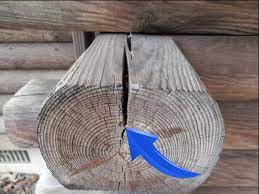
Air leaks in a log home can significantly affect energy efficiency, making it harder to maintain a comfortable indoor temperature and increasing heating and cooling costs. Here are common causes of air leaks in log homes and some strategies for repairing them.
Causes of Air Leaks in a Log Home
- Log Settling and Shrinkage
Over time, logs in a home naturally shrink and settle, which can create gaps between them. As moisture levels in the logs decrease, the logs shrink, sometimes leaving spaces that allow air to pass through.
- Improperly Sealed Joints
The areas where logs meet, such as corner joints or where logs intersect are common spots for air leaks. If these joints were not properly sealed during construction, they could become problematic.
- Cracks in Logs
Log checking (small cracks in the wood) can occur as the wood dries. While small checks are common and generally not a structural concern, large checks can allow air infiltration.
- Improperly Installed or Aging Windows and Doors
Gaps around windows and doors, especially if they have not been properly weather-sealed, can allow air leaks. The expansion and contraction of logs can also shift window and door frames, creating gaps over time.
- Gaps Around Utility Penetrations
Areas where pipes, electrical wiring, and other utilities penetrate the exterior walls can be prone to air leaks if they aren’t properly sealed with caulking or foam insulation.
How to Detect Air Leaks
- Visual Inspection: Look for visible gaps between logs, around windows and doors, and where utilities enter the home.
- Draft Test: On a windy day, feel for drafts around doors, windows, and log joints.
- Blower Door Test: A professional energy audit using a blower door test can help identify specific areas where air leaks are occurring.
Repairing Air Leaks in a Log Home
- Chinking
Chinking is the flexible material applied between logs to seal gaps. Modern chinking materials are elastic, allowing them to expand and contract with the movement of the logs. If gaps between logs develop, applying or reapplying chinking can help block air leaks.
Materials: Synthetic chinking is durable and flexible, lasting longer than traditional materials.
Process: Clean out any old chinking or debris, then apply new chinking using a caulking gun or trowel. Make sure it adheres well to both logs.
- Caulking
Caulking can be used to seal smaller cracks and gaps around windows, doors, and utility penetrations. Like chinking, use a high-quality, flexible caulk that can withstand the expansion and contraction of the logs.
Areas to Target: Around window and door frames, between logs, and in any visible cracks or checks in the wood.
3. Log Gaskets and Foam Tape
For large gaps or areas that need extra insulation, log gaskets (foam strips) or foam tape can be applied between logs before applying chinking. This helps ensure a tighter seal.
Application: Place gaskets or tape in areas where logs meet or where logs have shifted to provide a buffer against air leaks.
- Weatherstripping
Installing or replacing weatherstripping around doors and windows is an easy fix for preventing air from leaking around these areas. There are various types of weatherstripping, including adhesive-backed foam or rubber strips.
Installation: Ensure that the weatherstripping fits snugly and replace any old or worn materials that may have degraded over time.
- Log Maintenance (Sealing and Staining)
Regularly sealing and staining your log home helps to protect the logs from moisture, which can lead to further shrinkage and cracking. A properly maintained exterior reduces the likelihood of air leaks developing in the first place.
Process: Every few years, apply a high-quality sealant and stain to the exterior logs to protect them from moisture infiltration.
- Spray Foam Insulation
For larger gaps or difficult-to-reach areas, spray foam insulation can be used to block air leaks. It’s especially useful for areas where utilities enter the home or in crawl spaces and attics.
Caution: Be mindful of the type of foam used, as some foams can expand too much and cause damage to logs if improperly applied.
- Replacing Damaged Logs
If the air leak is due to severe rot or damage to the logs, you may need to replace the affected logs. Consult a professional to ensure the repair is done properly without compromising the structure.
Preventing Future Air Leaks
- Regular Inspections: Conduct regular checks of the exterior logs, joints, and window and door seals to catch potential issues early.
- Routine Maintenance: Keep up with sealing and staining to protect the logs from moisture and prevent shrinkage-related gaps.
- Proper Construction: Ensure that the log home was built with high-quality materials and craftsmanship. The initial installation of chinking, caulking, and other sealants is crucial for long-term energy efficiency.
By addressing air leaks promptly and performing regular maintenance, you can improve the energy efficiency and comfort of your home. Not to mention addressing areas where water and insects can cause further damage to your home. The team at 888 Log Guys offer an annual home inspection to help to address any potential issues with your home. Contact us today to learn more.








